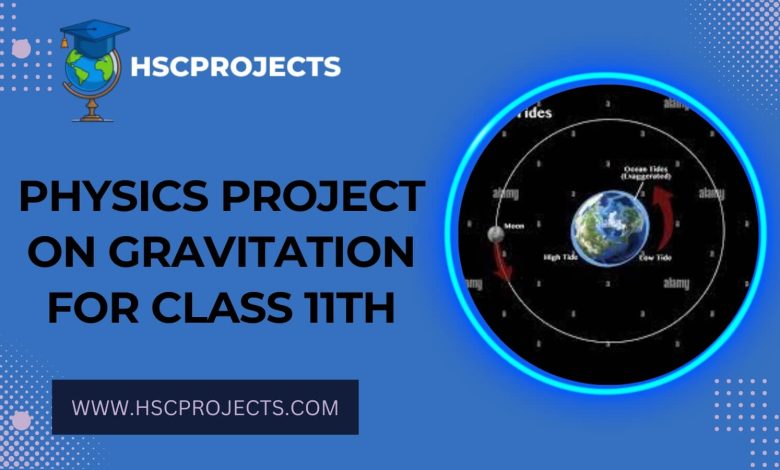
Physics Project On Gravitation For Class 11th
Acknowledgment
In the endeavor to compile and explore the vast realm of gravitation, this project has been a collaborative effort fueled by the passion, insights, and expertise of various individuals. Expressing gratitude to those whose contributions have shaped this exploration is not only a form of appreciation but a recognition of the collective spirit that propels scientific inquiry. A heartfelt thank you to the educators and guides who have imparted knowledge and fostered a curiosity for the intricacies of gravitation. Your guidance has been instrumental in shaping the foundation of this project. Gratitude is extended to the scientific luminaries whose groundbreaking work, from Newton’s elegant laws to Einstein’s revolutionary theories, has paved the way for a deeper understanding of gravitation. Acknowledgment is given to researchers and innovators who continue to push the boundaries of knowledge, applying gravitation in diverse fields such as space exploration, environmental monitoring, and medical sciences.
To fellow enthusiasts and learners who share in the fascination of gravitation, your curiosity and engagement have added a dynamic element to this exploration. It is the collective pursuit of knowledge that makes the journey meaning. Thanks to the engineers and technologists who apply gravitational principles to design and implement solutions, from satellite orbits to GPS systems. Your practical applications of gravitation contribute to advancements that impact our daily lives. Recognition goes to the environmental stewards who leverage gravitational methods for monitoring and understanding Earth’s dynamic systems. Your work is crucial in addressing challenges related to climate change and environmental sustainability.
Introduction
Greetings, fellow cosmic explorers! Welcome to a journey that transcends the boundaries of our earthly existence—a voyage into the captivating realm of gravitation. In this physics project tailored for the inquisitive minds of Class 11, we embark on an odyssey that unravels the mysteries of the force that orchestrates the cosmic ballet.
- The Allure of Gravitation: Gravitation, the silent maestro of the universe, guides the motion of celestial bodies with an invisible hand. From the graceful orbits of planets around stars to the mesmerizing dance of moons and satellites, the influence of gravity is omnipresent. As we delve into this project, we will peel back the layers of understanding surrounding gravitation, exploring its historical roots, fundamental principles, and modern applications.
- The Historical Tapestry: Our journey begins with Sir Isaac Newton, the luminary whose insights in the 17th century laid the foundation for our comprehension of gravity. Newton’s Law of Universal Gravitation serves as our compass, pointing us toward the heart of gravitational forces that shape the cosmos.
- From Earth to the Cosmos: Venture beyond the confines of our planet as we explore how gravity molds the motion of celestial bodies. Witness the intricacies of planetary orbits, the balletic choreography of satellites, and the peculiar phenomenon of weightlessness experienced by astronauts in the cosmic void.
- Hands-On Exploration: In the spirit of scientific inquiry, our odyssey takes a practical turn. Join us in an experiment designed to measure the acceleration due to gravity on Earth. Through this hands-on experience, we aim to bridge theory with real-world observation, fostering a deeper understanding of the gravitational forces that shape our daily lives.
- Einstein’s Cosmic Symphony: As we navigate further into the project, we encounter the revolutionary ideas of Albert Einstein. General relativity redefines our perception of gravity, unveiling a cosmic symphony where massive objects warp the fabric of spacetime itself.
- Cosmic Conundrums: Our odyssey concludes with a gaze into the cosmic unknown—dark matter. Explore the gravitational mysteries that hint at the existence of an elusive substance, challenging our understanding of the universe’s gravitational dance. Embark on this cosmic odyssey with us as we unravel the threads of gravitation, from Newton’s classical revelations to Einstein’s cosmic symphony. Let the exploration begin, and may the gravitational forces that govern our universe reveal their secrets in the pages that follow.

Features of Gravitation
- Universal Force: Gravitation is a universal force that acts between all objects with mass. It is not confined to specific materials or types of matter, making it a fundamental force in the cosmos.
- Inverse Square Law: According to Newton’s Law of Universal Gravitation, the force of gravity between two objects is inversely proportional to the square of the distance between their centers. This mathematical relationship elegantly explains the weakening of gravitational attraction with increasing distance.
- Mass Dependent: The force of gravity is directly proportional to the masses of the interacting objects. Larger masses exert a stronger gravitational pull, influencing nearby objects to a greater extent.
- Directional Force: Gravity is an attractive force that always acts along the line joining the centers of two masses. It pulls objects toward each other, giving rise to phenomena such as the orbiting of planets around stars and moons around planets.
- Indirect Influence on Light: According to Einstein’s theory of general relativity, gravity can bend the path of light. Massive objects, like stars and galaxies, can act as gravitational lenses, distorting and bending the light that passes near them.
- Keeps Planets in Orbit: Gravitational forces play a crucial role in keeping planets in orbit around the sun. The balance between the inward gravitational pull and the outward centrifugal force due to the planet’s motion maintains a stable orbit.
- Determines Weight: An object’s weight is the force of gravity acting on it. The weight of an object on Earth is proportional to its mass and the acceleration due to gravity on Earth’s surface.
- Impacts Tides: The gravitational pull of the moon and the sun on Earth causes the phenomenon of tides. The gravitational forces exerted by these celestial bodies lead to the rise and fall of ocean levels.
- Influences Celestial Motions: Gravitation governs the motions of celestial bodies, influencing the paths of comets, asteroids, and other objects in space. It is a key factor in the dynamics of galaxies and the large-scale structure of the universe.
- Key to Orbital Mechanics: Understanding gravitational principles is crucial in orbital mechanics. Artificial satellites, spacecraft, and space probes rely on gravitational interactions for their trajectories and orbits.
- Constant Acceleration: All objects near the Earth’s surface experience the same acceleration due to gravity, commonly denoted as ‘g.’ This constant acceleration allows for uniform motion and is approximately 9.8 meters per second squared on the Earth’s surface.
- Fundamental to Astrophysics: Gravitation is a cornerstone in astrophysics, playing a pivotal role in the formation and behavior of stars, galaxies, and other cosmic structures. It shapes the evolution of the cosmos on both large and small scales.
These features collectively define the intricate and pervasive nature of gravitation, showcasing its influence on the dynamics and structure of the universe.
Objectives of Gravitation Study
- Understanding Fundamental Forces: To comprehend the fundamental force of gravitation as it acts universally between objects with mass and influences their motion.
- Applying Newton’s Law of Universal Gravitation: To apply Newton’s Law of Universal Gravitation in calculating the gravitational force between two masses, exploring its mathematical principles and implications.
- Exploring the Inverse Square Law: To investigate and understand the inverse square law, realizing how gravitational force weakens with an increase in the square of the distance between masses.
- Analyzing Mass Dependence: To explore the direct proportionality between gravitational force and the masses of interacting objects, recognizing that larger masses exert stronger gravitational pulls.
- Studying Orbital Mechanics: To delve into the principles of orbital mechanics, understanding how gravitational forces govern the motion and stability of planets, moons, satellites, and other celestial bodies.
- Investigating Celestial Motions: To examine the role of gravitation in the dynamics of celestial bodies, including planets, stars, galaxies, and their interactions within the cosmic environment.
- Appreciating Einstein’s General Relativity: To appreciate the concepts of general relativity and understand how Einstein’s theories expand our understanding of gravitation, especially in the context of massive objects warping spacetime.
- Exploring Weight and Mass Relationship: To establish the relationship between weight and mass, recognizing that an object’s weight is the force of gravity acting on it, and understanding how this varies on different celestial bodies.
- Analyzing Tidal Phenomena: To investigate the gravitational forces responsible for tidal phenomena, understanding how the moon and the sun influence Earth’s tides through their gravitational interactions.

Applications of Gravitation
- Space Exploration: Spacecraft often utilize gravitational assists from celestial bodies during their trajectories. By carefully planning gravitational slingshots around planets, spacecraft can gain energy, alter their course, and travel more efficiently through the solar system.
- Satellite Orbits: Gravitation plays a crucial role in establishing and maintaining the orbits of communication satellites. The balance between gravitational forces and centripetal motion ensures that satellites remain in predictable positions, facilitating global communication networks.
- Tidal Energy: Gravitational forces exerted by the moon and the sun cause ocean tides. Tidal energy is harnessed by technologies such as tidal turbines, converting the kinetic energy of tides into electrical power.
- Timekeeping Systems: In satellite communication systems, precise timekeeping is essential. Gravitational time dilation, as predicted by general relativity, is taken into account to synchronize clocks on satellites, ensuring accurate data transmission.
- Planetary Motion Simulations: Astronomical Software: Gravitational principles are employed in software used for simulating planetary motion. These simulations assist astronomers, educators, and enthusiasts in visualizing the orbits and interactions of celestial bodies.
- Aerospace Engineering: Aerospace engineers use gravitational principles to calculate and plan the trajectories of spacecraft. This knowledge is crucial for satellite launches, interplanetary missions, and space exploration endeavors.
- Geophysics: Gravitational methods are used to measure the mass of the Earth. Instruments like gravimeters help geophysicists study variations in gravitational acceleration, providing insights into the composition and density of Earth’s interior.
- Medical Imaging: Understanding how the human body responds to gravitational forces is vital for space travel and medical research. Studies involving gravitational physiology contribute to advancements in healthcare and space medicine.
- Astrophysics: Gravitational effects on galaxies are crucial in the study of dark matter. The observed gravitational interactions help astrophysicists map the distribution of dark matter in the universe.

Conclusion
In closing our exploration of the cosmic force that binds the universe together, we find ourselves standing at the crossroads of wonder and understanding. Gravitation, the silent maestro of celestial symphonies, has revealed itself through the intricacies of planetary orbits, the dance of galaxies, and the bending of light in the cosmic expanse.
From Newton’s classical revelations to the revolutionary concepts of Einstein’s general relativity, our journey through gravitation has been a testament to the unyielding curiosity of the human mind. It has illuminated the pathways of stars, guided the trajectories of spacecraft, and unfurled the secrets hidden in the folds of spacetime.
The advantages of gravitation extend beyond the astronomical, influencing technological innovations on Earth, from satellite communication to the harnessing of tidal energy. It serves not only as a cosmic force shaping the grandeur of the cosmos but also as a practical ally in our quest for knowledge and progress.
As we reflect on the gravitational odyssey, we stand on the shoulders of giants—Newton, Einstein, and the countless minds that have pondered the mysteries of the universe. Gravitation, with its universal embrace, continues to beckon us toward further inquiry, inviting us to unravel the tapestry of the cosmos and discover the unseen threads that connect us to the vast reaches of space.
May our ongoing exploration of gravitation be fueled by the same spirit of curiosity and inquiry that has propelled us thus far. For in the cosmos, where gravitational forces shape the destiny of celestial bodies, our journey is but a small yet significant part of the grand cosmic narrative.
As we turn the final page of this gravitational odyssey, let the echoes of celestial harmonies linger, inspiring future explorers to delve even deeper into the gravitational mysteries that beckon from the cosmic horizon. The gravitational journey continues, and with it, our insatiable quest to fathom the profound secrets of the universe.
Certificate of Completion
Certificate of Completion
[Student’s Name][Class/Grade Level]This is to certify that I, [Student’s Name], a [Class/Grade Level] student, have successfully completed the “Physics Project On Gravitation For Class 11th”.The project explores the fundamental principles and key aspects of the chosen topic, providing a comprehensive understanding of its significance and implications.
In this project, I delved into in-depth research and analysis, investigating various facets and relevant theories related to the chosen topic. I demonstrated dedication, diligence, and a high level of sincerity throughout the project’s completion.
Key Achievements:
Thoroughly researched and analyzed Physics Project On Gravitation For Class 11th.
Examined the historical background and evolution of the subject matter.
Explored the contributions of notable figures in the field.
Investigated the key theories and principles associated with the topic.
Discussed practical applications and real-world implications.
Considered critical viewpoints and alternative theories, fostering a well-rounded understanding.
This project has significantly enhanced my knowledge and critical thinking skills in the chosen field of study. It reflects my commitment to academic excellence and the pursuit of knowledge.
Date: [Date of Completion]Signature: [Your Signature] [School/Institution Name][Teacher’s/Examiner’s Name and Signature]
In order to download the PDF, You must follow on Youtube. Once done, Click on Submit
Follow On YoutubeSubscribed? Click on Confirm
Download Physics Project On Gravitation For Class 11th PDF






